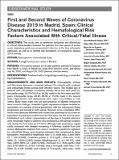Por favor, use este identificador para citar o enlazar a este item:
http://hdl.handle.net/10261/231339COMPARTIR / EXPORTAR:
 SHARE SHARE
 CORE
BASE CORE
BASE
|
|
| Visualizar otros formatos: MARC | Dublin Core | RDF | ORE | MODS | METS | DIDL | DATACITE | |

| Título: | First and Second Waves of Coronavirus Disease 2019 in Madrid, Spain: Clinical Characteristics and Hematological Risk Factors Associated With Critical/Fatal Illness |
Autor: | Mollinedo-Gajate, Irene; Villar-Álvarez, Felipe; Zambrano-Chacón, María de los Ángeles; Núñez-García, Laura; Dueña-Muñoz, Laura de la; López-Chang, Carlos; Górgolas-Hernández-Mora, Miguel; Cabello, Alfonso; Sánchez-Pernaute, Olga; Romero-Bueno, Fredeswinda; Aceña, Álvaro; González-Mangado, Nicolás; Peces-Barba, Germán; Mollinedo, Faustino CSIC ORCID | Palabras clave: | Blood biomarkers Coronavirus disease 2019 Critical/fatal illness First and second wave of infection Prognosis Risk factors Severe acute respiratory syndrome coronavirus 2 |
Fecha de publicación: | feb-2021 | Editor: | Lippincott Williams & Wilkins Society of Critical Care Medicine |
Citación: | Critical Care Explorations 3(2): e0346 (2021) | Resumen: | Objectives: This study aims to determine similarities and differences in clinical characteristics between the patients from two waves of severe acute respiratory syndrome coronavirus-2 infection at the time of hospital admission, as well as to identify risk biomarkers of coronavirus disease 2019 severity. Design: Retrospective observational study. Setting: A single tertiary-care center in Madrid. Patients: Coronavirus disease 2019 adult patients admitted to hospital from March 4, 2020, to March 25, 2020 (first infection wave), and during July 18, 2020, and August 20, 2020 (second infection wave). Interventions: Treatment with a hospital-approved drug cocktail during hospitalization. Measurements and Main Results: Demographic, clinical, and laboratory data were compared between the patients with moderate and critical/fatal illness across both infection waves. The median age of patients with critical/fatal coronavirus disease 2019 was 67.5 years (interquartile range, 56.75–78.25 yr; 64.5% male) in the first wave and 59.0 years (interquartile range, 48.25–80.50 yr; 70.8% male) in the second wave. Hypertension and dyslipidemia were major comorbidities in both waves. Body mass index over 25 and presence of bilateral pneumonia were common findings. Univariate logistic regression analyses revealed an association of a number of blood parameters with the subsequent illness progression and severity in both waves. However, some remarkable differences were detected between both waves that prevented an accurate extrapolation of prediction models from the first wave into the second wave. Interleukin-6 and d-dimer concentrations at the time of hospital admission were remarkably higher in patients who developed a critical/fatal condition only during the first wave (p < 0.001), although both parameters significantly increased with disease worsening in follow-up studies from both waves. Multivariate analyses from wave 1 rendered a predictive signature for critical/fatal illness upon hospital admission that comprised six blood biomarkers: neutrophil-to-lymphocyte ratio (≥ 5; odds ratio, 2.684 [95% CI, 1.143–6.308]), C-reactive protein (≥ 15.2 mg/dL; odds ratio, 2.412 [95% CI, 1.006–5.786]), lactate dehydrogenase (≥ 411.96 U/L; odds ratio, 2.875 [95% CI, 1.229–6.726]), interleukin-6 (≥ 78.8 pg/mL; odds ratio, 5.737 [95% CI, 2.432–13.535]), urea (≥ 40 mg/dL; odds ratio, 1.701 [95% CI, 0.737–3.928]), and d-dimer (≥ 713 ng/mL; odds ratio, 1.903 [95% CI, 0.832–4.356]). The predictive accuracy of the signature was 84% and the area under the receiver operating characteristic curve was 0.886. When the signature was validated with data from wave 2, the accuracy was 81% and the area under the receiver operating characteristic curve value was 0.874, albeit most biomarkers lost their independent significance. Follow-up studies reassured the importance of monitoring the biomarkers included in the signature, since dramatic increases in the levels of such biomarkers occurred in critical/fatal patients over disease progression. Conclusions: Most parameters analyzed behaved similarly in the two waves of coronavirus disease 2019. However, univariate logistic regression conducted in both waves revealed differences in some parameters associated with poor prognosis in wave 1 that were not found in wave 2, which may reflect a different disease stage of patients on arrival to hospital. The six-biomarker predictive signature reported here constitutes a helpful tool to classify patient’s prognosis on arrival to hospital. | Versión del editor: | https://doi.org/10.1097/CCE.0000000000000346 | URI: | http://hdl.handle.net/10261/231339 | DOI: | 10.1097/CCE.0000000000000346 | E-ISSN: | 2639-8028 |
| Aparece en las colecciones: | (PTI Salud Global) Colección Especial COVID-19 (CIB) Artículos |
Ficheros en este ítem:
| Fichero | Descripción | Tamaño | Formato | |
|---|---|---|---|---|
| First_and_Second_Waves_of_Coronavirus_Disease_2019.13.pdf | 2,03 MB | Adobe PDF |  Visualizar/Abrir |
CORE Recommender
PubMed Central
Citations
20
checked on 22-abr-2024
SCOPUSTM
Citations
22
checked on 17-abr-2024
Page view(s)
140
checked on 24-abr-2024
Download(s)
125
checked on 24-abr-2024

